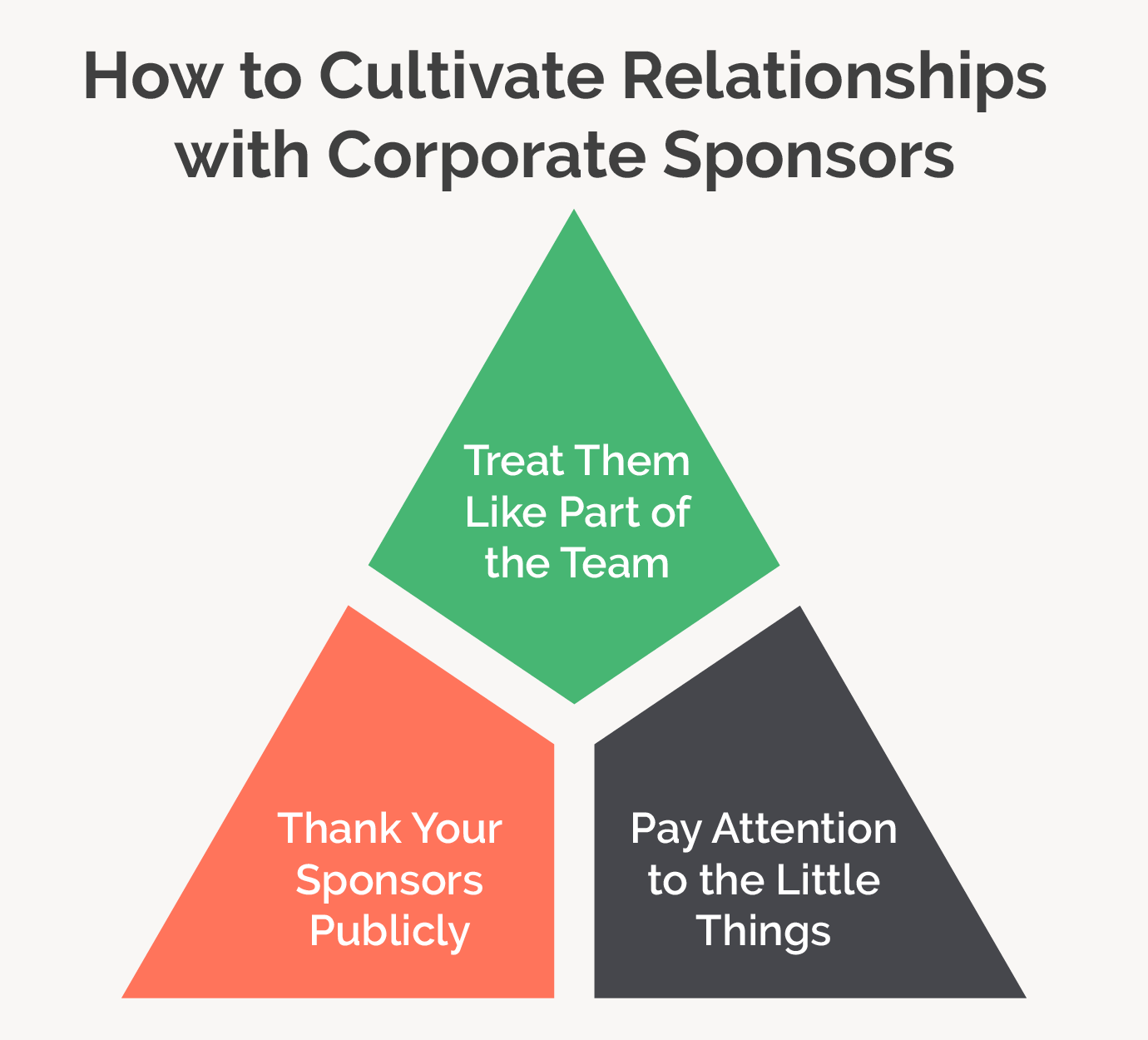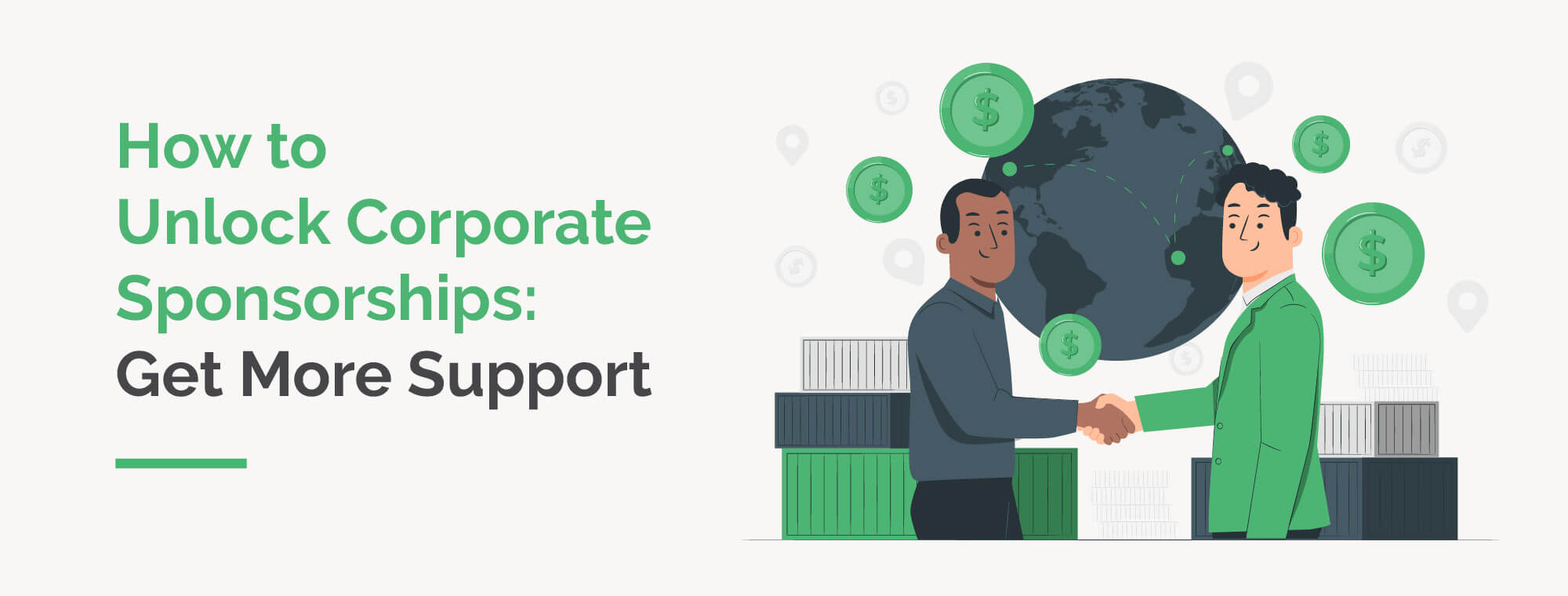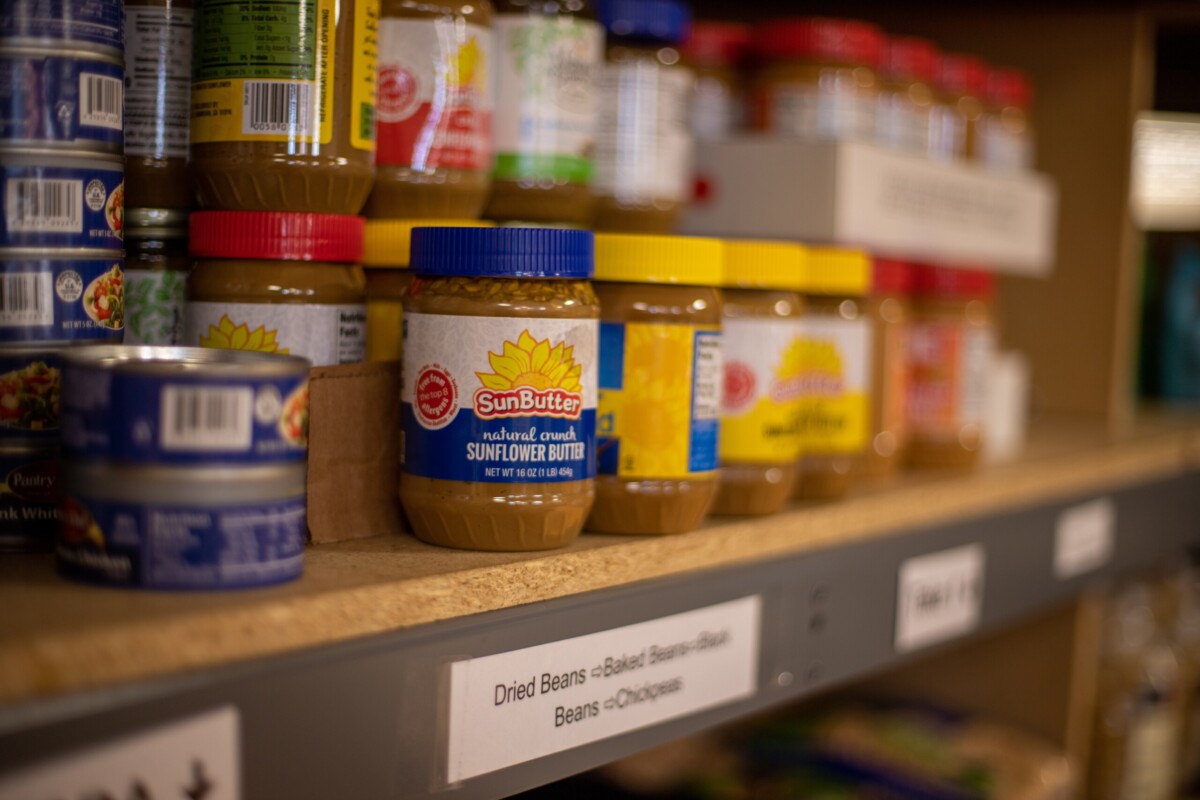How to Ask for a Corporate Sponsorship
Once you’ve identified corporations you want to partner with, it’s time to plan how you’ll approach them. Forming the right ask depends on your goals, who you’re reaching out to, and when you plan to make contact. Here’s a helpful list of strategies to help you make the ask:
Promote Your Sponsorship Page
Creating a sponsorship page on your nonprofit’s website is a great way to condense the must-know information about sponsoring your organization. Include information like:
- Your sponsorship levels
- A case for support that explains why you need sponsors
- How an interested company can reach out to your team
Then, promote this page across different channels, such as social media and paid advertising platforms like Google Ads. You can tap into paid advertising for free with the Google Ad Grant! If you apply and are approved, you can promote content like your sponsorship page on Google Search Results for relevant keywords.
Finding the right keywords can take some work, but you can always turn to a professional to handle the work for you. A Google Ad Grants expert like Getting Attention can help you optimize your sponsorship landing page and promote it using Google Ads.
Be Creative
You can ask a company to sponsor just about anything. Use aspects of your event that already exist, and turn them into sponsorship perks. Then, be sure to position them as excellent sponsorship opportunities for your potential partners.
Set the Right Sponsorship Levels
Just like you receive a variety of donation amounts from individual supporters, establish multiple levels of sponsorship for corporations to agree to. If you have an event with hundreds or thousands of people, make sure your sponsorship levels are high enough (such as $1,000 and up). You don’t want sponsorship to be priced so high that no one will want to participate, but by keeping levels elevated, sponsors will feel like the event is well-run and that you have confidence in what you’re doing.
On the other hand, if you’re planning a smaller event and have difficulty securing a large sponsorship, consider offering a lower sponsorship level with fewer perks. For instance, you could offer a $100 level for smaller businesses not interested in the larger sponsorship opportunity.

Explain Why You’re a Perfect Fit
As you make your ask, explain how this corporate partnership will contribute to building up the company’s brand. Do your missions align? What will working with your nonprofit help the company achieve in terms of its own goals? Keep these in mind and communicate them as clearly as possible.
Ask About the Company’s Objectives
That said, asking the company directly about its objectives and priorities demonstrates that you’re genuinely interested in bringing value to the partnership. Remember, your corporate sponsors have objectives, or “missions,” of their own. They’ll want to know they’re supporting a nonprofit that aligns with these goals and that the sponsorship can help them achieve them.
Tell a Story
Explain to potential sponsors how their sponsorship and support can directly impact someone as part of your mission. For instance, “$1,000 will help us provide meals to 5 families of 4 for a week.” Additionally, share how last year’s sponsors were able to help your organization accomplish its goals.
Tailor Your Ask
Rather than using one main template and filling in names, make your ask personal and write individualized letters. These should be addressed to a relevant person at the company who is most likely to be receptive to hearing about your cause. Make sure you do your research on who to ask. Go beyond just marketing contacts and speak to anyone who will sympathize with your mission and also be in a position to create a plan of action!
Consider In-Kind Donations
If a business declines to offer a monetary sponsorship, consider asking for a non-monetary sponsorship instead, such as coupons for free services on event day. You can also request that a portion of their proceeds on the event day be donated back to the organization. A business in the area could serve as a location for the kick-off party, packet pick-up, or after-event party.
You can also reach out to companies to provide services you’ll need at the event, such as photography, DJ/entertainment, signage, food, portable toilets, and tent/chair rentals. The value of their goods or services can certainly equate to a sponsorship level.
Leverage Your Data
Always back up your corporate sponsorship asks with supporter data! Determine what demographics a sponsor is targeting, and provide them with information about your event that would be relevant. For example, if a company tends to target women aged 50 to 60, let the company know how many people or what percentage of participants attending your event fall into that group.
Find the Right Timing
The timing of your sponsorship ask is important. A lot of larger companies earmark a specific amount of money each calendar year for charitable giving, so be sure to ask when is the best time for them to consider a sponsorship.
Oftentimes, you have to get your ask in very early to even be considered. Other times, you have to adjust your strategy to the business you’re reaching out to. For instance, if you’re reaching out to an accounting firm during tax season, you’re most likely not top-of-mind, and your request may go unanswered.
Propose a Plan
Part of crafting an appealing sponsorship ask means outlining your campaign initiatives and success metrics. This means defining your fundraising goal and the impact it will have first and foremost.
As mentioned before, use numbers and data to support your proposal. But also be sure to define your success metrics and use KPI benchmarks that show when you’ve achieved your fundraising goals. Be specific about how your organization plans to meet its objectives, and link this process to ongoing projects, as well.
Draft a Sponsorship Agreement
The biggest thing that will demonstrate that you’re professional and committed to the partnership is a sponsorship agreement. It should be written down to outline your goals, expectations, and other deliverables for your organization and the company. It’s also a good idea to include how you’re going to recognize the company for its support, such as through advertising materials, merchandise, or event printouts.
Follow Up
Haven’t heard back? Don’t give up! Continue to communicate with companies after you’ve reached out with a corporate sponsorship request. Always check back to ensure someone has received your call, email, or letter. If not, ask to speak to the appropriate person at the company, and/or resend your ask to that person.
How to Cultivate Relationships with Corporate Sponsors
Once you’ve secured your corporate sponsorship, don’t let the relationship fall by the wayside! In addition to presenting your partnership in a professional light, continuing to recognize and work with your sponsor can have a huge impact on your organization.
Here are some effective ways to work with a sponsor after they’ve agreed to support your cause:

Treat Them Like Part of the Team
Treat your corporate sponsors like part of the team, because they are part of the team. Many sponsors will feel more engaged and recognize that they’re getting more from their sponsorship if they hear from you often. This doesn’t mean sending them an email every day, but rather, treating them like a team member.
Use the same engagement tools and approaches you use with participants to connect with your sponsors. For fundraising events, offer them a free team captain registration, help them get their page set up, and provide fundraising coaching. The more a sponsor raises and the larger their team, the more exposure they will get. This will in turn make them feel like they’re getting more out of the sponsorship.
Pay Attention to the Little Things
Yes, big perks matter, but the little touchpoints make a big difference, too. Send a handwritten thank-you letter or a note from a participant or beneficiary of your cause’s work. If the sponsor also fundraised for your campaign, create a top fundraisers certificate that you send to them by mail.
These little touchpoints show that you acknowledge the importance of their support, yet the cost is minimal, which demonstrates good stewardship by not wasting the sponsor’s money.
Thank Your Sponsors Publicly
Feature sponsor logos and information in your event materials, such as merchandise, pamphlets, and online advertisements and emails. Then, give a shoutout on social media! Tag their company or business page, and publicly thank them in a post.
This will help your sponsor gain exposure as a reward for supporting your event, and it will also help solidify your partnership as beneficial and worthwhile in terms of the company’s branding. Most likely, the company will then re-post your original post to its full audience to help your event reach new constituents.
Additional Corporate Giving Programs
Corporate sponsorships are a fantastic source of funding and support for your nonprofit’s events and projects. But you should also research other forms of corporate philanthropy. Especially when combined with a corporate partnership, other types of philanthropy can maximize your fundraising revenue and keep your supporters engaged.
Of course, managing different areas of workplace giving like matching gifts, volunteer grants, payroll giving, and more can be tricky if you don’t have a centralized platform. Seek out software that can help you identify opportunities, collect data, and share insights for oft-overlooked types of corporate giving. This way, you’ll be able to capitalize on more opportunities for support, growing your funding and support through one organized database.
Here are a few of the different types of corporate giving opportunities your nonprofit can seek out and manage with software:
Matching Gifts and Fundraising Matches
Corporate matching gifts are the most popular type of corporate giving program with more than 26 million individuals working for companies with matching gift programs.
Through these programs, companies match the donations their employees make to eligible nonprofits. Typically, these matching gifts occur at a 1:1 ratio, but some companies will match at a higher rate. This means that your donors’ gifts could be doubled (or even tripled!) at no additional cost to the supporter.
Additionally, some employers match funds their employees raise on behalf of a nonprofit. For example, if you hold a walk-a-thon and an employee raises $250 in pledged donations, the match would bring it to a grand total of $500!
If you’ve already set up a partnership with a company, their employees will be encouraged to donate to your cause. While they are a popular form of corporate giving, matching gifts are still an overlooked revenue source. That’s why it’s important to raise awareness among all of your donors and supporters, whether they’re connected to known sponsors or not.

To help raise awareness among your supporters about matching gifts, consider investing in matching gift software. A solution like 360MatchPro by Double the Donation offers:
- A comprehensive matching gift database that houses information about thousands of companies and their corporate giving programs. Donors can search for their employers using a straightforward search tool, which can be easily embedded into your website.
- Email tools that help you identify matching gift opportunities within your existing donor database and trigger emails to relevant donors.
- Email address detection tools that can identify opportunities based on a donor’s email domain. For example, 360MatchPro can automatically pick up that an email address like donorname@wellsfargo.com means the donor likely works for Wells Fargo.
- Follow-up emails that remind donors to check with their employer for matching gift opportunities.
- Automatic match request submission for donors whose employers use a CSR software vendor that partners with Double the Donation.
These are just a few of the features that 360MatchPro offers to spread awareness of matching gifts, remind employees to apply for them, and allow you to take advantage of this key revenue stream.
#Unlock #Corporate #Sponsorships #Support










